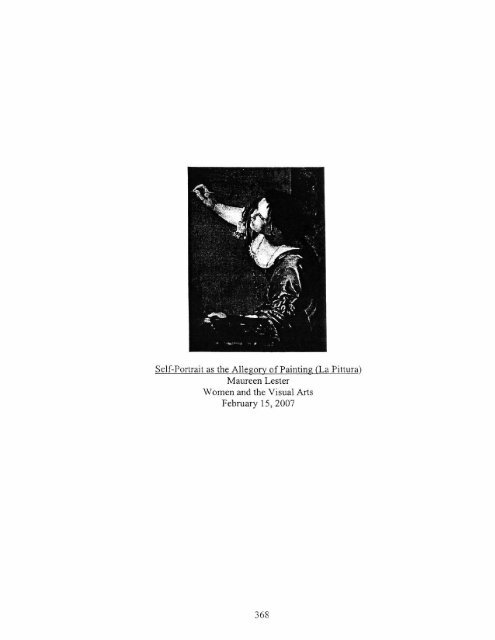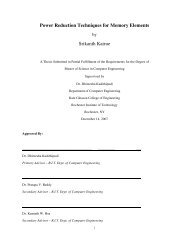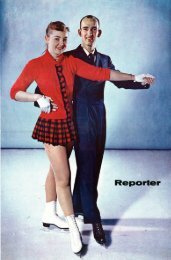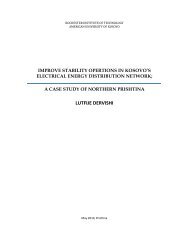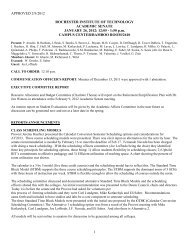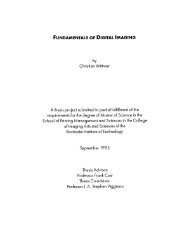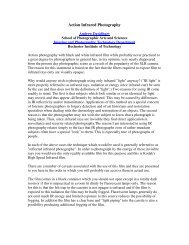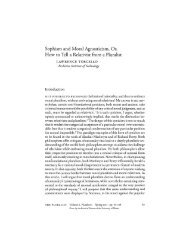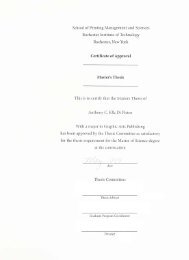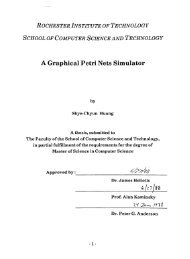Self-Portrait as the Allegory of Painting (La Pittura) Maureen Lester ...
Self-Portrait as the Allegory of Painting (La Pittura) Maureen Lester ...
Self-Portrait as the Allegory of Painting (La Pittura) Maureen Lester ...
You also want an ePaper? Increase the reach of your titles
YUMPU automatically turns print PDFs into web optimized ePapers that Google loves.
<strong>Self</strong>-<strong>Portrait</strong> <strong>as</strong> <strong>the</strong> <strong>Allegory</strong> <strong>of</strong> <strong>Painting</strong> (<strong>La</strong> <strong>Pittura</strong>)<br />
<strong>Maureen</strong> <strong>Lester</strong><br />
Women and <strong>the</strong> Visual Arts<br />
February 15, 2007<br />
368
— Use his (Michelangelo's) brush. Do a self-portrait,' [Orazio] whispered slowly. 'An <strong>Allegory</strong><br />
<strong>of</strong> <strong>Painting</strong>. For all time." 'Si, Papa.' I kissed him lightly on <strong>the</strong> forehead. will (Vreeland<br />
315)." Thus Susan Vreeland's novel. The P<strong>as</strong>sion <strong>of</strong> Artemisia, ends, with <strong>the</strong> death <strong>of</strong><br />
Artemisia Gentileschi's fa<strong>the</strong>r and <strong>the</strong> beginning <strong>of</strong>, arguably, one <strong>of</strong> her most important works.<br />
However, <strong>as</strong> nice <strong>as</strong> it would be to take this version <strong>of</strong> events <strong>as</strong> <strong>the</strong> truth, <strong>the</strong> fact is that many<br />
details <strong>of</strong> <strong>the</strong> origin <strong>of</strong> <strong>the</strong> painting known <strong>as</strong> <strong>Self</strong>-<strong>Portrait</strong> <strong>as</strong> <strong>the</strong> <strong>Allegory</strong> <strong>of</strong> <strong>Painting</strong> (<strong>La</strong><br />
<strong>Pittura</strong>) are a matter <strong>of</strong> much debate. Although <strong>the</strong>re is no doubt that this is an Artemisia piece,<br />
its exact date <strong>of</strong> completion, <strong>as</strong> well <strong>as</strong> its status <strong>as</strong> an actual self-portrait h<strong>as</strong> caused much<br />
discussion and speculation.<br />
The issue <strong>of</strong> self-portraiture in <strong>La</strong> <strong>Pittura</strong> is one <strong>of</strong> great importance given <strong>the</strong> subject<br />
matter. Simply put, Artemisia's painting, if indeed a self-portrait, w<strong>as</strong> one that no man could<br />
ever have painted (Garrard 97). Tradition dictated that <strong>the</strong> art <strong>of</strong> painting be represented by an<br />
allegorical female figure, forcing male artists to address <strong>the</strong> <strong>the</strong>mes <strong>of</strong> artist portrait and allegory<br />
<strong>of</strong> painting separately (97). However, this necessity led to certain problems. Until <strong>the</strong><br />
Renaissance, painting had been considered manual labor, and thus placed <strong>the</strong> practitioners <strong>of</strong> <strong>the</strong><br />
craft at a low position <strong>of</strong> society (101). The practice <strong>of</strong> employing an allegorical figure for<br />
painting, which emerged during <strong>the</strong> 16 th century, served to convey <strong>the</strong> idea that art w<strong>as</strong> separate<br />
from <strong>the</strong> manual process required to make it, and that its essence w<strong>as</strong> superior to that <strong>of</strong> <strong>the</strong><br />
individual artist (101). This ability to separate <strong>the</strong> end result from <strong>the</strong> manual labor established<br />
painting <strong>as</strong> a Fine Art, one that required inspiration and creative thought <strong>as</strong> opposed to learned<br />
skill (101). However, although representation <strong>of</strong> <strong>Pittura</strong> (painting) served to elevate <strong>the</strong> practice<br />
<strong>of</strong> <strong>the</strong> art, it did nothing to fur<strong>the</strong>r <strong>the</strong> status <strong>of</strong> <strong>the</strong> artist personally, save if it w<strong>as</strong> depicted on <strong>the</strong><br />
walls <strong>of</strong> <strong>the</strong> artist's house (104). Several artists, including V<strong>as</strong>ari with his <strong>Allegory</strong> <strong>of</strong> <strong>the</strong> Arts in<br />
369
his Florentine home and Federico Zuccaro with <strong>the</strong> Apo<strong>the</strong>osis <strong>of</strong> <strong>the</strong> Artist in his Roman<br />
palazzo, relied on this method (101). The necessity <strong>of</strong> <strong>the</strong> placement <strong>of</strong> <strong>the</strong>se images within<br />
artist homes made <strong>the</strong>ir effectiveness extremely limited, <strong>as</strong> <strong>the</strong>y worked to elevate <strong>the</strong> artist only<br />
so far <strong>as</strong> <strong>the</strong>y lived <strong>the</strong>re, and were on display to a limited amount <strong>of</strong> people.<br />
In order to fur<strong>the</strong>r <strong>the</strong>ir own status, artists <strong>of</strong>ten turned to self-portraiture, where <strong>the</strong>ir<br />
status <strong>as</strong> gentleman w<strong>as</strong> emph<strong>as</strong>ized (Garrard 102). Typically, <strong>the</strong> artist would paint <strong>the</strong>mselves<br />
with <strong>the</strong> tools <strong>of</strong> <strong>the</strong>ir art (palette, brushes, mahlstick, e<strong>as</strong>el, etc.), <strong>of</strong>fset by fine clo<strong>the</strong>s and o<strong>the</strong>r<br />
indicators <strong>of</strong> being a learned individual, such <strong>as</strong> <strong>the</strong> Greek poem that Antonio Moro attached to<br />
his self-portrait that is currently located in <strong>the</strong> Uffizi (102). Artists would <strong>of</strong>ten include<br />
<strong>the</strong>mselves wearing a golden chain <strong>as</strong> an indicator <strong>of</strong> <strong>the</strong> rank conferred upon him by a ruler.<br />
However, <strong>the</strong>se methods were also problematic. The latter method w<strong>as</strong> not an effective means <strong>of</strong><br />
communicating <strong>the</strong> sitter's status <strong>as</strong> an artist, unless he w<strong>as</strong> famous enough to be recognized on<br />
sight, because o<strong>the</strong>r types <strong>of</strong> noblemen were given chains and medallions by rulers (104). The<br />
fanner method, while more clearly an indicator <strong>of</strong> <strong>the</strong> artist's status, w<strong>as</strong> incredibly risky given<br />
that <strong>the</strong> inclusion <strong>of</strong> studio paraphernalia evoked <strong>as</strong>sociations with manual labor, despite <strong>the</strong><br />
fineness <strong>of</strong> his clo<strong>the</strong>s (104). In fact, <strong>the</strong> finer <strong>the</strong> clo<strong>the</strong>s, <strong>the</strong> more out <strong>of</strong> place <strong>the</strong> artist looked<br />
in <strong>the</strong> studio setting (104). Attempts to circumvent this problem resulted in <strong>the</strong> depiction <strong>of</strong> <strong>the</strong><br />
studio <strong>as</strong> a place were <strong>the</strong> arts were discussed and debated, <strong>as</strong> well <strong>as</strong> practiced, such <strong>as</strong> in <strong>the</strong><br />
work Academy by Baccio Bandinelli (104). Still, this portrayal in not without its problems, with<br />
<strong>the</strong> link between <strong>the</strong> studio and a place <strong>of</strong> dialogue tenuous, relying almost entirely on <strong>the</strong><br />
inscription included in <strong>the</strong> work (105). Ano<strong>the</strong>r method employed to slightly more success w<strong>as</strong><br />
put forth by G.D. Cerrini, in his piece <strong>Allegory</strong> <strong>of</strong> <strong>Painting</strong> with <strong>Self</strong>-<strong>Portrait</strong> <strong>of</strong> <strong>the</strong> Artist, in<br />
which <strong>the</strong> female personification <strong>of</strong> <strong>the</strong> art holds a portrait <strong>of</strong> <strong>the</strong> artist, and Poussin with his self-<br />
370
portrait <strong>of</strong> 1650, in which he reversed Cerrini's arrangement, placing himself <strong>as</strong> <strong>the</strong> living<br />
character painting an image <strong>of</strong> <strong>Pittura</strong> (106). Yet even in <strong>the</strong>se, <strong>the</strong> artist is separate from <strong>the</strong> art<br />
he creates. Fur<strong>the</strong>rmore, <strong>the</strong>se means <strong>of</strong> combining <strong>the</strong> two <strong>the</strong>mes were <strong>of</strong>ten elaborate and<br />
complicated, at odds with <strong>the</strong> public's desire for abstract ide<strong>as</strong> to be rendered in clear, simple,<br />
cohesive images (106).<br />
In contr<strong>as</strong>t to previous attempts to link <strong>the</strong> allegorical with portraiture, if it is an actual<br />
self-portrait, Ariemisia's piece is radically simplified (Garrard 106). The composition takes<br />
many <strong>of</strong> its details directly from Cesare Ripa's Iconologia (Christiansen and Mann 417).<br />
Iconologia w<strong>as</strong> originally published in 1593, and provided an index <strong>of</strong> allegorical figures,<br />
gestures and attributes to be used by painters (Pingel, par. 4). In fact, Ripa's description <strong>of</strong><br />
"<strong>Painting</strong>," though not exactly a description <strong>of</strong> <strong>the</strong> painting, sounds very similar to <strong>the</strong><br />
Artemisia's piece:<br />
A beautiful woman, with full black hair, disheveled, and twisted in various ways, with<br />
arched eyebrows that show imaginative thought, <strong>the</strong> mouth covered with a cloth tied<br />
behind her ears, with a chain <strong>of</strong> gold at her throat from which hangs a m<strong>as</strong>k, and h<strong>as</strong><br />
written in front "imitation." She holds in her hand a brush, and in <strong>the</strong> o<strong>the</strong>r <strong>the</strong> palette,<br />
with clo<strong>the</strong>s <strong>of</strong> evanescently covered drapery... (Christiansen and Mann 417-18).<br />
<strong>La</strong> <strong>Pittura</strong>, does indeed feature a young woman with dark hair in a ra<strong>the</strong>r unkempt state, with a<br />
chain featuring a m<strong>as</strong>k pendant (67). Brush in hand, <strong>the</strong> figure reaches forward <strong>as</strong> if to apply to<br />
first strokes to a blank canv<strong>as</strong>, with one hand, while her o<strong>the</strong>r holds a palette (67). The painting<br />
is signed "A.G.F." with <strong>the</strong> "F" most likely referring to a variation <strong>of</strong> <strong>the</strong> <strong>La</strong>tin verb fecere,<br />
meaning "to make (Christiansen and Mann 418).<br />
371
The piece shows remarkable skill in its use <strong>of</strong> color. Ripa's description <strong>of</strong> painting also<br />
included a reference to drappo cangiante, a technique discussed in by Lomazzo in a 1584 treatis<br />
on painting that demonstrated an artist's skill in handling color by painting a p<strong>as</strong>sage <strong>of</strong> cloth<br />
with one color in <strong>the</strong> lights and a different in <strong>the</strong> shadows (Garrard 107). The sleeves <strong>of</strong> <strong>the</strong><br />
figure's dress run from violet to green, showc<strong>as</strong>ing <strong>the</strong> technique (107). She fur<strong>the</strong>r exhibits<br />
color m<strong>as</strong>tery through <strong>the</strong> careful relationships developed throughout <strong>the</strong> painting. The red-<br />
brown background, which seems to dominate <strong>the</strong> composition, continues onto <strong>the</strong> bodice <strong>of</strong> <strong>the</strong><br />
dress, were it is balanced by <strong>the</strong> dark green <strong>of</strong> <strong>the</strong> blouse and <strong>the</strong> sleeve's blue-violet highlights<br />
(107). The flesh <strong>of</strong> <strong>the</strong> figure h<strong>as</strong> been carefully modeled, with white highlights employed to<br />
precisely establish spatial planes (107). The entire color scheme is echoed by <strong>the</strong> five color<br />
patches on <strong>the</strong> figure's palette, serving almost <strong>as</strong> a sort <strong>of</strong> summary (107). What is perhaps most<br />
interesting about <strong>the</strong> color use <strong>of</strong> this piece, is that it might suggest, according to Garrard,<br />
Artemisia's choosing a side in <strong>the</strong> various art schools debate <strong>of</strong> colore (color) versus disegno<br />
(design), aligning herself with <strong>the</strong> former (107). If indeed true, it adds a sort <strong>of</strong> irony to<br />
Vreeland's novel <strong>as</strong> far <strong>as</strong> <strong>the</strong> creation <strong>of</strong> <strong>La</strong> <strong>Pittura</strong> is created. As mentioned in <strong>the</strong> introduction<br />
<strong>of</strong> <strong>the</strong> paper, Vreeland ends her novel with Artemisia promising to use Michelangelo's brush to<br />
create <strong>the</strong> painting (315). Michelangelo, however, w<strong>as</strong> a champion <strong>of</strong> disegno, which makes <strong>the</strong><br />
idea <strong>of</strong> Artemisia employing his brush to create a work that clearly speaks to color over design<br />
quite humorous.<br />
Artemisia continues her adherence to Ripa's description <strong>of</strong> painting with <strong>the</strong> inclusion <strong>of</strong><br />
<strong>the</strong> tabula r<strong>as</strong>a, or blank slate, before <strong>the</strong> figure, which stresses, according to him "<strong>the</strong> primacy <strong>of</strong><br />
<strong>the</strong> artistic idea, <strong>as</strong> superior to <strong>the</strong> particular depicted image on <strong>the</strong> canv<strong>as</strong> that follows in its<br />
wake" (Christiansen and Mann 67). She fur<strong>the</strong>rmore evokes <strong>the</strong> contr<strong>as</strong>t between Theory and<br />
372
Practice, or <strong>the</strong> relationship between <strong>the</strong> material concerns <strong>of</strong> painting with its higher <strong>as</strong>pects <strong>of</strong><br />
intellect (Garrard 108). With one aim raised upward, <strong>the</strong> hand stretching toward an invisible<br />
target, she suggests <strong>the</strong> painting's higher ide<strong>as</strong>, while <strong>the</strong> o<strong>the</strong>r arm firmly resting on <strong>the</strong> table<br />
holding <strong>the</strong> tools <strong>of</strong> painting conjures up <strong>the</strong> notion <strong>of</strong> material concerns (109). In <strong>La</strong> <strong>Pittura</strong>,<br />
however, instead <strong>of</strong> separating <strong>the</strong> two <strong>as</strong> w<strong>as</strong> common, Artemisia unites <strong>the</strong>m in a continuous<br />
arc in <strong>the</strong> composition (109). The head serves <strong>as</strong> <strong>the</strong> center <strong>of</strong> <strong>the</strong> arc, speaking to <strong>the</strong> fact that<br />
<strong>the</strong> two diverse ide<strong>as</strong> are joined in <strong>the</strong> mind <strong>of</strong> <strong>the</strong> artist, and provides a point <strong>of</strong> resolution for<br />
<strong>the</strong> two <strong>as</strong>pects (109). That she chose to suggest this abstract allegory through a realistic human<br />
form suggests that Artemisia believed that painting's worth <strong>as</strong> art derives from <strong>the</strong> work <strong>of</strong> <strong>the</strong><br />
artist ra<strong>the</strong>r that <strong>as</strong>sociation with royalty or <strong>the</strong>oretical pretension (109).<br />
Artemisia takes some creative license in her painting <strong>as</strong> well. According to Ripa, <strong>Pittura</strong><br />
w<strong>as</strong> supposed to wear a long dress covering her feet, creating a metaphor between <strong>the</strong> covered<br />
female body and <strong>the</strong> ideal proportions <strong>of</strong> painting, established in <strong>the</strong> underdrawing but disguised<br />
in <strong>the</strong> final work when <strong>the</strong> color is added (Garrard 107). Artemisia ignores this focus, and<br />
instead leaves out <strong>the</strong> skirt and feet altoge<strong>the</strong>r, placing <strong>the</strong> figure in a foreshortened, transitory,<br />
active pose (107). In doing so, she prevents <strong>the</strong> viewer from discovering <strong>the</strong> conventional<br />
symmetry, beauty, and proportion, <strong>as</strong> well <strong>as</strong> <strong>the</strong> arched eyebrows, that Ripa had specified (107).<br />
It is important to note that <strong>the</strong> canv<strong>as</strong> w<strong>as</strong> cleaned in 1972, which removed later<br />
repainting on <strong>the</strong> background (Bissell 272). Certain are<strong>as</strong> were painted ra<strong>the</strong>r thinly on <strong>the</strong> finely<br />
woven canv<strong>as</strong>, which, coupled with loss <strong>of</strong> glazes, have resulted in <strong>the</strong> dark preparatory ground<br />
to be visible in some places (272). This renders <strong>the</strong> impression <strong>the</strong> picture w<strong>as</strong> unfinished, but<br />
that is not <strong>the</strong> c<strong>as</strong>e (272).<br />
373
While indeed a fine example <strong>of</strong> <strong>the</strong> allegory <strong>of</strong> painting, much debate h<strong>as</strong> arisen over its<br />
status <strong>as</strong> an actual self-portrait since Michael Levey identified <strong>the</strong> artist in 1962 (Garrard 97).<br />
One <strong>of</strong> <strong>the</strong> leading voices amongst those in disagreement with <strong>the</strong> <strong>as</strong>sumption is R. Ward Bissell,<br />
who believes that "<strong>the</strong> woman is not Artemisia in <strong>the</strong> guise <strong>of</strong> or conjoined with "<strong>La</strong> <strong>Pittura</strong>, but<br />
a semi-idealized if exceptionally contemporary and spirited personification <strong>of</strong> that Art" (272).<br />
Instead, Bissell feels that <strong>La</strong> <strong>Pittura</strong> w<strong>as</strong> designed to accompany a separate, fully recognizable<br />
self-portrait <strong>of</strong> Artemisia that h<strong>as</strong> since been lost (272). Mainly, Bissell argues that <strong>the</strong>re is little<br />
relation between <strong>the</strong> face seen in <strong>La</strong> <strong>Pittura</strong> and <strong>the</strong> known Artemisia visages seen in an<br />
anonymous portrait medal and an engraving done by Jerome David, <strong>as</strong> well <strong>as</strong> Artemisia's own<br />
Female Martyr (273). Missing from <strong>La</strong> <strong>Pittura</strong> are <strong>the</strong> double chin and puffy eyebrows which<br />
are characteristics <strong>of</strong> Artemisia's face, and would have been accentuated by <strong>the</strong> pr<strong>of</strong>ile view <strong>of</strong><br />
<strong>the</strong> image (273). However, o<strong>the</strong>rs feel <strong>the</strong> wide forehead, full cheeks, bow lips, and ample, if not<br />
double, chin are reminiscent <strong>of</strong> <strong>the</strong> artist's face (Christiansen and Mann 418). Fur<strong>the</strong>rmore, in<br />
comparing <strong>La</strong> <strong>Pittura</strong> with o<strong>the</strong>r images thought to portray Artemisia likeness, <strong>the</strong>re are several<br />
re<strong>as</strong>ons for discrepancies. First, only David's engraving, with its inscription stating <strong>as</strong> recording<br />
a self-portrait, provides a true indication <strong>of</strong> how Artemisia may have f<strong>as</strong>hioned an image <strong>of</strong><br />
herself (Christiansen and Mann 421). There is clear mention <strong>of</strong> several self-likenesses produced<br />
by Artemisia, not all <strong>of</strong> which have been identified, though <strong>the</strong> ones that have seem to cover a<br />
variety <strong>of</strong> types (421). Thus, we may not even be aware yet <strong>of</strong> what constitutes a proper self-<br />
portrait <strong>of</strong> Artemisia (421). Fur<strong>the</strong>rmore, when considering <strong>La</strong> <strong>Pittura</strong>, it is important to know<br />
that <strong>the</strong> very nature <strong>of</strong> <strong>the</strong> piece is to "o<strong>the</strong>r" <strong>the</strong> figure represented (Bal 139). The image created<br />
w<strong>as</strong> design to represent an allegory, and plays and abstract <strong>the</strong>ory against <strong>the</strong> personal<br />
representation (139).<br />
374
Arguments have also been proposed that Artemisia's portrayal <strong>of</strong> herself <strong>as</strong> <strong>Painting</strong>,<br />
with a prominent chain and unusually small m<strong>as</strong>k <strong>as</strong> seen in <strong>La</strong> <strong>Pittura</strong>, w<strong>as</strong> intended to<br />
represent <strong>the</strong> artist <strong>as</strong> serving her current patron, and that she no doubt employed herself <strong>as</strong> <strong>the</strong><br />
model, albeit in a highly original f<strong>as</strong>hion (Christiansen and Mann 420). The set-up required to<br />
paint a self-portrait in <strong>the</strong> way <strong>of</strong> <strong>La</strong> <strong>Pittura</strong> w<strong>as</strong> difficult, requiring two mirrors, and would seem<br />
to support <strong>the</strong> bo<strong>as</strong>ting found in letters to Don Antonio Ruffio in Sicily, in which she wrote<br />
statements such <strong>as</strong> "And I will show our Most illustrious Lordship what a woman can do," and<br />
"You will find <strong>the</strong> spirit <strong>of</strong> Caesar in this soul <strong>of</strong> a woman" (420).<br />
Besides <strong>the</strong> issue <strong>of</strong> <strong>the</strong> actual image, questions <strong>of</strong> self-portraiture arise over how <strong>the</strong><br />
piece w<strong>as</strong> referred to in inventories. In <strong>the</strong> inventory <strong>of</strong> 1687-88 <strong>of</strong> <strong>the</strong> English Royal Collection<br />
<strong>the</strong>re is two references "Ar<strong>the</strong>misia gentilesco. Done by her selfe," and "Pintura A painteigne"<br />
(274). Levey presumes that <strong>the</strong>se attributions were for <strong>the</strong> same image, representing a self-<br />
portrait and <strong>the</strong> <strong>Allegory</strong> <strong>of</strong> <strong>Painting</strong>, however, no where else does ano<strong>the</strong>r painting appear twice<br />
in <strong>the</strong> inventory (274). Thus Bissell believes <strong>the</strong>re were in fact two separate paintings, meaning<br />
<strong>La</strong> <strong>Pittura</strong> is not a self-portrait.<br />
Ano<strong>the</strong>r issue opened for debate is when and where this painting w<strong>as</strong> created, <strong>as</strong> well <strong>as</strong><br />
for whom w<strong>as</strong> it originally intended. The provenance <strong>of</strong> <strong>La</strong> <strong>Pittura</strong> cannot be traced back earlier<br />
than 1649, when it w<strong>as</strong> already in England (Garrard 110). It is here that it is first mentioned in<br />
<strong>the</strong> inventory collections <strong>of</strong> Charles I (110). However, many have connected <strong>the</strong> piece with one<br />
<strong>of</strong> Artemisia's principal Italian patrons, Roman scholar C<strong>as</strong>siano dal Pozzo (110). Three letters<br />
written from Naples in 1639 to C<strong>as</strong>siano mention a promise to deliver a self-portrait he had<br />
requested (110). No fur<strong>the</strong>r mention <strong>of</strong> a self-portrait for C<strong>as</strong>siano occurs until 1637, when<br />
Artemisia wrote to him that among <strong>the</strong> paintings she proposed to ship to Rome, pending a reply,<br />
375
w<strong>as</strong> "ano<strong>the</strong>r for Your Eminence, in addition to my portrait in conformity with that which you<br />
once requested, to be numbered among {your o<strong>the</strong>r portraits] <strong>of</strong> illustrious painters," (Bissell<br />
274). Several scholars believe that <strong>La</strong> <strong>Pittura</strong> w<strong>as</strong> <strong>the</strong> self-portrait mentioned in 1630, and that it<br />
w<strong>as</strong> painted at that time, given <strong>the</strong> age (approximately thirty-seven years old) <strong>of</strong> <strong>the</strong> woman in<br />
<strong>the</strong> picture (274). This is not a fair indicator, <strong>as</strong> <strong>the</strong>re are many examples throughout art history<br />
<strong>of</strong> individuals painted in <strong>the</strong> appearance <strong>of</strong> <strong>the</strong>ir prime, when in fact <strong>the</strong>y are much older.<br />
Moreover, in order for this dating to be true, Artemisia had to have retained <strong>the</strong> self-portrait<br />
intended for C<strong>as</strong>siano for seven years, and <strong>the</strong>n brought it to London in 1638, a fact that is highly<br />
unlike given that it would mean she had broken her promise to him in 1630, and <strong>the</strong>n continued<br />
to seek patronage from him later (274). Even if <strong>the</strong> painting had been sent in early 1631 to<br />
C<strong>as</strong>siano, and subsequently p<strong>as</strong>sed to Cardinal Francesco Barberini in 1937, <strong>the</strong>re is no mention<br />
<strong>of</strong> a painting by Artemisia amongst <strong>the</strong> portraits <strong>of</strong> o<strong>the</strong>r famous individuals (275).<br />
Stylistically, Garrard dates <strong>the</strong> painting to around 1630 (111). Given its naturalism and<br />
lighting, <strong>the</strong> piece shares many similarities with Artemisia's early Caraveggesque period (111).<br />
However, <strong>the</strong> brushstrokes used in <strong>La</strong> <strong>Pittura</strong> are freer than <strong>the</strong> paintings <strong>of</strong> <strong>the</strong> 1620s, and<br />
feature a more sophisticated combination <strong>of</strong> blurred and sharp edges (111). However, it does not<br />
yet have <strong>the</strong> fluidity <strong>of</strong> <strong>the</strong> painted works <strong>of</strong> <strong>the</strong> 1640's, which are also much more idealized than<br />
seen in <strong>La</strong> <strong>Pittura</strong>. Bissell, however, sees <strong>the</strong> most stylistic similarity with Artemisia's<br />
contributions to Orazio Gentileschi's 1638 ceiling for <strong>the</strong> Queen's House at Greenwich (273). In<br />
particular, <strong>the</strong> position <strong>of</strong> <strong>the</strong> arms and heads, cl<strong>as</strong>sicizing facial types, fluidity, shining<br />
highlights, robust physiques, and bold chiaroscuro speaks to <strong>La</strong> <strong>Pittura</strong> (273). Thus, he places<br />
<strong>the</strong> date at roughly 1638, and that she brought it with her when she came to England (272).<br />
376
Despite all <strong>the</strong> debate, <strong>Self</strong>-<strong>Portrait</strong> <strong>as</strong> <strong>the</strong> <strong>Allegory</strong> <strong>of</strong> <strong>Painting</strong> (<strong>La</strong> <strong>Pittura</strong>) is an exquisite<br />
piece. Imbued with <strong>the</strong> frenzy <strong>of</strong> creation, Artemisia created an image that in all likelihood<br />
represented herself at le<strong>as</strong>t partially. Despite, <strong>the</strong> <strong>as</strong>suredness <strong>of</strong> Vreeland's novel, one can only<br />
speculate <strong>as</strong> to <strong>the</strong> extent that this image captures her own.<br />
377
Bibliography<br />
Bal, Mieke. "Grounds <strong>of</strong> Comparison." The Artemisia Files: Artemisia Gentileschi for Feminist<br />
and O<strong>the</strong>r Thinking People. Ed. Mieke Bal. Chicago: University <strong>of</strong> Chicago Press, 2005.<br />
Bissell, R. Ward. Artemisia Gentileschi and <strong>the</strong> Authority <strong>of</strong> Art: Critical Reading and<br />
Catalogue Raisonne. University Park, PA: Pennsylvania Sate University Press, 1999.<br />
Christiansen, Keith and Judith W. Mann. Orazio and Artemisia Gentileschi. New York:<br />
Metropolitan Museum <strong>of</strong> Art, 2001.<br />
Emblem Books in Bryn Mawr College Library Special Collections. Ed. Pingel, Claire E. 2001.<br />
14 February 2007 <br />
Garrard, Mary D. "Artemisia Gentileschi's <strong>Self</strong>-<strong>Portrait</strong> <strong>as</strong> <strong>the</strong> <strong>Allegory</strong> <strong>of</strong> <strong>Painting</strong>." The Art<br />
Bulletin 62 (1980): 97-112.<br />
Vreeland, Susan. The P<strong>as</strong>sion <strong>of</strong> Artemsia. New York: Penguin Group, 2002.<br />
378


